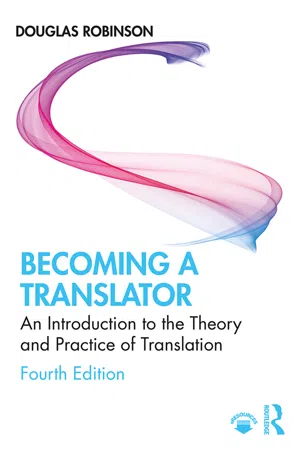
Becoming a Translator
An Introduction to the Theory and Practice of Translation
- 304 pages
- English
- ePUB (mobile friendly)
- Available on iOS & Android
About this book
Fusing theory with advice and information about the practicalities of translating, Becoming a Translator is the essential resource for novice and practicing translators. The book explains how the market works, helps translators learn how to translate faster and more accurately, as well as providing invaluable advice and tips about how to deal with potential problems, such as stress.
The fourth edition has been revised and updated throughout, offering:
- a whole new chapter on multimedia translation, with a discussion of the move from "intersemiotic translation" to "audiovisual translation," "media access" and "accessibility studies"
- new sections on cognitive translation studies, translation technology, online translator communities, crowd-sourced translation, and online ethnography
- "tweetstorms" capturing the best advice from top industry professionals on Twitter
- student voices, especially from Greater China
Including suggestions for discussion, activities, and hints for the teaching of translation, and drawing on detailed advice from top translation professionals, the fourth edition of Becoming a Translator remains invaluable for students and teachers of Translation Studies, as well as those working in the field of translation.
Frequently asked questions
- Essential is ideal for learners and professionals who enjoy exploring a wide range of subjects. Access the Essential Library with 800,000+ trusted titles and best-sellers across business, personal growth, and the humanities. Includes unlimited reading time and Standard Read Aloud voice.
- Complete: Perfect for advanced learners and researchers needing full, unrestricted access. Unlock 1.4M+ books across hundreds of subjects, including academic and specialized titles. The Complete Plan also includes advanced features like Premium Read Aloud and Research Assistant.
Please note we cannot support devices running on iOS 13 and Android 7 or earlier. Learn more about using the app.
Information
1
External knowledge
- Internal and external knowledge
- Reliability
- Textual reliability
- The translator’s reliability
- Timeliness
- Cost
- Conclusion
- Discussion
- Exercises
- Suggestions for further reading
Internal and external knowledge
| Internal | External |
| A translator thinks and talks about translation from inside the process, knowing how it's done, possessing a practical real-world sense of the problems involved, some solutions to those problems, and the limitations on those solutions (the translator knows, for example, that no translation will ever be a perfectly reliable guide to the original). | A nontranslator (especially a monolingual reader in the target language who directly or indirectly pays for the translation - a client, a book-buyer) thinks and talks about translation from outside the process, not knowing how it's done but knowing, as Samuel Johnson once said of the non-carpenter, a well-made cabinet when s/he sees one. |
Reliability
Textual reliability
Table of contents
- Cover
- Half Title
- Title
- Copyright
- Contents
- List of figures
- List of tables
- Acknowledgments
- Preface to the fourth edition
- Introduction
- 1 External knowledge: the user’s view
- 2 Internal knowledge: the translator’s view
- 3 The process of translation
- 4 Drawing on experience: how being a translator is more than just being good at languages
- 5 Starting with people: social interaction as the first key focus of translators’ experience of the world
- 6 Working with people: the workplace as the interactive setting for specialized terminologies
- 7 Translation as an operation performed in and on languages
- 8 Translation as an operation performed in and on multimedia
- 9 Working and understanding through social networks
- 10 The impact on translation of culture(s)
- 11 When habit fails
- References
- Index